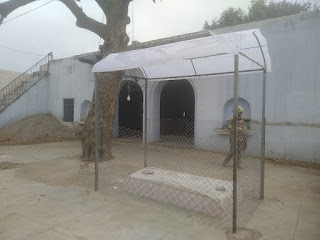NAU-GAJA MEMORIAL, KUTEENA
Nau-Gaja
A memorial built to show respect and gratitude towards the martyrs
of war in 1880s between the villagers of Kuteena and King of
Neemrana of that time.
Etymology –
This was named Nau-Gaja after the length of Pagari or
Rajputi turban that is 9 guz (1 guz is 0.91 metres). It is considered as a symbol
of huge respect among the community.
History -
The head of village at that time was Shri Phool Singh
Chauhan, retired from Bikaner Risala (Cavalry of that time). He began
constructing a fort to secure the village from invasions. A courtier of
Maharaja of Neemrana, namely Kalu Singh, originally from Kuteena itself, saw
the construction and recited a mind-made story to him that the fort is being
constructed to fight against the King and overpower him.
Maharaja, with his army, headed towards
Kuteena (in 1880s). Villagers gathered and fought against them to stop the
destruction. When the king was surrounded by soldiers of kuteena
in the mid-war, he surrendered and asked for treaty negotiations. Then he was
asked the reason of attack. When he came to know that Kalu singh was the
culprit of the confusion and loss, he apologized for not verifying the
authenticity of news and asked people to hand over Kalu Singh to him to punish
him for his sinful deed. He tied Kalu Singh to his elephant’s leg and moved
towards his palace. Kalu singh died at a small elevated sand dune area, now
known as Kalu Singh ka Teeba, near Kankar ki Dhani. His body was left there and
king sent compensations by providing more Jagirdari (land) to the people of
Kuteena.
While, the villagers decided to build a memorial at the
place of public gathering where in earlier days, Panchayat like gatherings were
done. The memorial was built with a Pars (slightly elevated throne like the
Takht on which Guru Granth Sahib is kept), with its head towards North
direction unlike Muslim’s Peer or Dargah in India specifically (which faces
west direction). It was named Nau-Gaja and people began worshiping it before
every meeting or auspicious occasion to gain blessings of their elders and show
respect towards them.
Tradition –
A white cloth also known as Chaddar of sawa do gaz, that is
2 and a quarter guz, is offered on the Pars at every auspicious occasion and
major festivals like Holi and Diwali by the people of this village in the
memory of Rajput martyrs of both the sides (in war). All that is offered is
taken by a Swami of Kankar after worshiping the same.
Other facts -
Now Muslims also worship the place by offering cloth of
white colour as per their belief considering it as one of their pir or peer as
at current time they form a very significant amount of population in this area.
They were also known as sakka from the name of their ancestors who used to work
as Bhisti or water-providing helpers. Their ancestor namely Khaju Khan and his
wife Joshana, were helped to hide from outrage of hindus at the time of
partition by the village head at that time Shri Phool Singh Chauhan ji.


Comments
Post a Comment